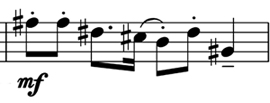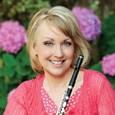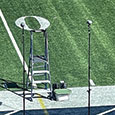Flash! by Daniel Dorff is a newly-published showpiece for piccolo and piano that was written for Kate Prestia-Schaub in 2008. The work has been well received and was the winner of the 2009 International Piccolo Symposium’s Composition Competition.
Prestia-Schaub first met Dorff after winning the National Flute Association piccolo competition in 2002 when she asked him for coaching on his Sonatine de Giverny to learn how he intended the work to sound.
Prestia-Schaub and Dorff had a serendipitous moment when it came to the title of this newest work. She states, “Flash is one of my nicknames because, when I was a teenager, my car caught on fire. Daniel did not know this when he named it, but we laughed at the synchronicity of it all!”
Dorff grew up as a classical saxophone player, so his woodwind writing has a natural style reminiscent of the French conservatory composers. He was also influenced by the sound of 1970s rock and roll (he loved the Beatles and Motown) and jazz. This music is flashy, tonal, and exciting to play and hear.
Flash! is only 6 1/2 minutes long. Written in ternary form, the sections are A, measures 1-93; B, measures 94-194; and A, measures 195 to the end. The opening G-major arpeggio pattern introduces a rhythmic motive that unifies the piece. You will find many arpeggiated triplet figures sprinkled throughout the work, both ascending and descending. Take extra rehearsal time to work out the ensemble with the piano in the first few measures. The rhythm is a bit tricky. Written in 58, the piano plays on beats 1, 2, 3, and the & of 4, and has a rest on 5. Over that ostinato rhythm the piccolo plays the previous music example.

Dorff refers to the section that begins at measure 94 as the misterioso scary section. “I went through a lot of sketches before getting something I really liked. Then one afternoon the whole section from 94-128 spilled out as fast as I could write it down. I do mean for the pianist to keep the pedal down as indicated to keep the polychords sounding scary. Those dynamics with the whooshing crescendos in the piano are important”.
Dorff characterizes much of this section as transposed repetition: “Tonal music stays fresh by being interesting: bars 129-171 are a development of bars 60-96”. There are many motives that return slightly reworked throughout the piece, for instance, the small motive at measure 60 returns in a sequential treatment in bars 129-131:
mr. 60
.jpg)
mrs. 129-131



Interrelationships are prevalent in this work and give Flash! a tightly engineered feeling. The music fits together almost like the inner workings of a fine watch.
Dorff added, “The idea of having a very slow passage right before the recapitulation can be both profound and humorous in performance, perhaps the slower the better. It’s sort of like a ‘prayer scene’ before the big finale in many grand operas, and it’s also like saying on your mark, get set before the racing recapitulation which stays in G major until the end.”
The passage he refers to is below. Notice that the intervallic relationships are the same as those in measure 60 and bars 129-131.

Prestia-Schaub adds that arpeggio practice is essential for learning this work. Look carefully at the scalar patterns because there are often unexpected pitches in a scale, or an expected pitch is omitted from a familiar pattern. Marking those particular places in the scales and arpeggios would probably be advisable.
This is a wonderful showy work that would make an impression on any recital. Dorff enjoys writing for the piccolo and treats it in a rather serious, flute-like way rather than just as a novelty instrument.





